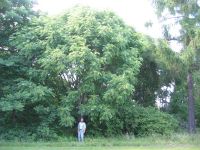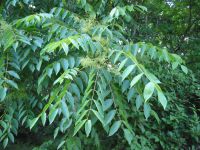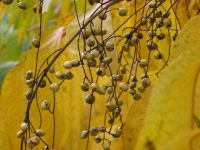Varnish Tree - Rhus verniciflua
English name:
Varnish Tree
Scientific name:
Rhus verniciflua
Family:
Anacardiaceae (Sumac family, (Cashew family))
Height:
15 - 20 m.
Flowering:
Late June, early July
Range:
China east to India, south to Vietnam
 |
|
 |
 |
The 25 year old Rhus verniciflua in the top picture is from seed received from Beijing Arboretum of the Chinese Academy of Forestry. The plant can be found on the north side of the second grass plain after one enters the main gait of the arboretum: in square 1412, position 2715.
Plant description:
There are many remarkable and important trees. One is Rhus verniciflua whose sap has been used to produce the first widely used plastic. This plastic is the lacquer of China and Japan that has been used to cover metal and wood objects for at least 4500 years. The sap of the tree Rhus verniciflua, is tapped much like latex is tapped from rubber trees. When properly aged, and painted on an object in atmosphere of high humidity, polymerization occurs forming a resilient, long lasting coating which repels water and resists acid, alkali, salt, and alcohol. It also insulates against heat and electricity. In both China and Japan many objects have been coated with this lacquer and traditional lacquered objects are a treasured part of their cultures. The fruit of Rhus verniciflua also is useful. The fruits have a high fat content, and have been used to produce a wax for candle making, cooking and for skin and hair care.
However, many parts of the plant are poisonous and (as in the related Rhus radicans, or Poison ivy), severe skin rashes can occur with contact with the raw sap. This is an allergic reaction and may need contact several times (or contact with a related species) for one to be sensitised. In rare cases people are reported to even react to the hardened lacquer made from this plant. The plant has also had medical uses and research on different compounds for the treatment of cancer has been undertaken with some success.
The genus Rhus contains about 200 temperate and subtropical trees. Many have attractive autumn colours and they have often found commercial use, both for the commercial products produced from them and as garden plants. However, many cause strong skin rashes. We have 9 species of Rhus in our collection and 3 specimens of Rhus verniciflua. All three R. verniciflua come from China (Gansu and Shaanxi provinces).
All three are thriving and growing vigorously. Our oldest two plants came from the Peking Arboretum of the Chinese Academy of Forestry in 1980.
Rhus verniciflua also goes under the name Toxicodendron verniciflua. It was introduced into Denmark as early as 1895. It is planted over much of Asia so that its natural distribution is uncertain. It was first introduced to the Arboretum as seed in 1950 but no plants have survived from that introduction.
These are vigorous, deciduous trees. The large, 25-80 cm long, compound leaves possess an odd number of leaflets. The leaflets are broadly ovate with an extended tip with un-toothed margins. The upper surface is shinny fresh green while the lower surface can have a velvet down. Autumn colours are red and yellow. Shoots are stout, pale green with orange-brown lenticels and a poisonous sap that turns black when exposed to air. Tiny whitish-yellow flowers occur in lax panicles from the axils of the current years shoots. The berry-like, glossy, yellowish fruit are 0.8 mm across. They are fleshy with a hard inner core surrounding a seed.
Like the rest of our Rhus collection one should only cautiously make direct contact with the plants, especially with their sap. While extremely interesting and while the source of many useful by products, Rhus verniciflua is not a plant I would recommend for the home garden.
References:
Bean, W.J. 1976 Trees and Shrubs Hardy in the British Isles Vol III. N-Rh. Bean and Murray publishers. 973 pp.
Lange, J. 1994. Kulturplanternes Indførselshistorie i Danmark. (Introduction History of Cultivated Plants in Denmark). Jordbrugsforlaget, Frederiksberg. 458 pp.
Mabberley, D.J. 1998. The Plant Book. The Bath Press, Bath, 858 pp.
Rushforth, K. 1999. Trees of Britain and Europe. Harper Collins Publisher. 1336 Pp.
Mitchell, A. & Ødum S. 1983. Træer i Nordeuropa. Gads forlag, Copenhagen, pp. 354-355.
Plants For A Future: https://pfaf.org/user/Default.aspx
Botanical Dermatology Database: http://bodd.cf.ac.uk/BotDermFolder/BotDermA/ANAC.html
